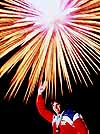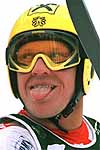|
From
Chamonix to Salt Lake City
Looking
back on great moments from Winter Olympic history
Author
Info
1924
Chamonix, France
Initially organized as an International Winter Sports Week, the
Games at Chamonix were not officially recognized as the first Winter
Olympics by the International Olympic
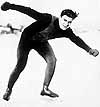 |
|
USOC
ARCHIVES
|
Committee until
1925. Five sports were represented: Nordic skiing, figure skating,
speed skating, bobsled and hockey.
Canada established its reign as hockey champions by winning the
gold in the first four Winter Olympics.
Anders Haugen (United States) was logged in as coming in fourth
in the ski jump, but a calculation error discovered in 1974 showed
he really placed third. At age 83, Haugen was awarded his bronze
medal.
Charles Jewtraw (United
States) won the United States’ only gold medal in the 500-meter
speed skating event.
1928
St. Moritz,
Switzerland
The second Winter Olympics used the facilities of an established
ski resort. It also was the first time since World War I that Germans
were admitted back into any Olympic competition.
The Games at St. Moritz were the only time that bobsled teams could
have five men instead of four. The United States placed first and
second in the event.
At age 15, Sonja Henie (Norway) won the first of three consecutive
gold medals in figure skating.
1932
Lake Placid,
United States
Due to the Depression, turnout was low, with only 17 nations participating.
Half of the athletes were from the United States or Canada. Dog
sledding was included as a demonstration sport.
John Shea (United States) won golds in the 500-meter and 1,500-meter
speed skating events.
The U.S. bobsled team captured gold for the second time in a row.
Team member Eddie Eagan became the only person to win a gold medal
in both the Winter and Summer Olympics. He already had a gold in
boxing from the 1920 Summer Games.
1936
Garmisch-Partenkirchen,
Germany
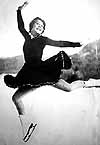 |
|
USOC
ARCHIVES
|
The Germans saw these Winter Games as a prelude to the Summer Games
in Berlin. An attempt by German emigrants in the United States for
a national boycott failed.
Ivan Brown and Alan Washbond (United States) won gold in the two-man
bobsled.
Great Britain’s hockey team toppled the Canadian hold on gold.
Sonja Henie (Norway) won her third consecutive gold medal,
making her the most successful individual woman figure skater.
1940
The Games were scheduled to be held in Sapporo, Japan, but war with
China caused Japan to pull out. Germany volunteered, but World War
II forced cancellation of the Winter Olympics until 1948.
1948
St. Moritz,
Switzerland
The popularity of Alpine skiing increased and slalom and downhill
events were added. The winter pentathlon (cross-country skiing,
downhill skiing, fencing, shooting and horse riding)was held as
a demonstration sport and was not successful.
Henri Oreiller (France) won two golds and one bronze in Alpine skiing
and was the most successful athlete of the 1948 Winter Games.
Barbara Ann Scott (Canada) became the first North American to win
a gold in figure skating.
Gretchen Fraser (United States) captured gold in the women’s
slalom, the United States’ first skiing medal.
1952
Oslo, Norway
Germany and Japan were allowed to compete for the first time since
World War II. The Oslo Games marked the first time the Olympics
were held in a Scandinavian country.
Andrea Mead (United States) was victorious in the slalom and giant
slalom, becoming the first U.S. athlete to win two golds in a Winter
Olympics.
Hjalmar Andersen (Norway) won golds in the 1,500-meter, 5,000-meter
and 10,000-meter speed skating events.
Richard Button (United States) won his second gold and was the first
to perform a triple jump in the figure skating competition.
1956
Cortina d’Ampezzo,
Italy
An Italian television station provided the first Winter Olympic
live coverage. “Eurovision” allowed parts of central Europe
to watch competition.
 |
|
USOC
ARCHIVES
|
The United States swept the men’s figure skating competition.
Gold went to Hayes Alan Jenkins, silver to Ronald Robertson and
bronze to David Jenkins, younger brother of Hayes.
Toni Sailer (Austria) won three gold medals in Alpine skiing.
The new Soviet hockey team upset Canada in the finals and
took the gold undefeated.
1960
Squaw Valley,
United States
The opening and closing ceremonies were stage-managed by Walt Disney,
chairman of the Olympic Pageantry Committee. South Africa was represented
for the first and last time until 1994. Figure skating events moved
indoors.
The U.S. hockey team defeated Canada and captured gold for the first
time.
Georg Thoma (Germany) became the first non-Scandinavian to win the
Nordic combined.
Barbara Wagner and Robert Paul (Canada) won the gold in pairs figure
skating.
1964
Innsbruck, Austria
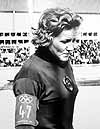 |
|
USOC
ARCHIVES
|
Computers helped officials time and judge events. Mild weather prompted
the Austrian military to truck in snow. Luge made its Olympic debut.
Lidia Skoblikova (U.S.S.R.) captured all the golds in women’s
speed skating.
Ortun Enderlein (Germany) won gold in the first women’s Olympic
luge event.
1968
Grenoble, France
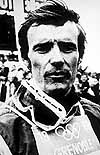 |
|
USOC
ARCHIVES
|
For the first
time there were two separate German teams competing in an Olympics.
Peggy Fleming (United States) took home the gold in women’s
figure skating.
U.S. speed skaters Mary Meyers, Dianne Holum and Jennifer Fish triple-tied
for silver in the 500-meter event.
Jean-Claude Killy (France), the host country’s favorite
son, won gold medals in all three Alpine skiing events. The Games
were dubbed the “Killympics.”
1972
Sapporo, Japan
The Sapporo Games were the first Winter Olympics held outside of
Europe and the United States. They also marked the first time all
three medals in one discipline were won by a non-European country
(Japan, in the normal hill ski jump).
Galina Kulakova (U.S.S.R.) captured three gold medals in women’s
cross-country skiing.
Speed skater Dianne Holum (United States) won a gold (1,500 meters)
and silver (3,000 meters). She would later coach Eric Heiden to
the 1976 and 1980 Olympics.
Barbara Cochran (United States) won the gold in the women’s
slalom by two-hundredths of a second.
1976
 |
|
USOC
ARCHIVES
|
Innsbruck, Austria
The Games were originally awarded to Denver but later nixed by Colorado
voters. Innsbruck used existing facilities from the 1964 Games.
Speed skater Sheila Young (United States) captured gold,
silver and bronze medals, making her the first U.S. athlete to win
three medals at a single Winter Olympics.
Franz Klammer (Austria) won gold in downhill skiing.
Ice dancing made its Olympic debut. Ludmilla Pakhomava and Alexander
Gorshkow (U.S.S.R.) took the first gold medal.
1980
Lake
Placid, United States
The second Lake
Placid Games marked the first use of artificial snow in Olympic
competition.
Eric Heiden (United States) won five gold medals in speed
skating.
Alexander Saizev and Irina Rodnina (U.S.S.R.) won gold in pairs
figure skating. It was her third consecutive gold medal.
The U.S. hockey “Dream Team” defeated the Soviets, who
had taken gold since 1964.
Ulrich Wehing (East Germany) garnered his third consecutive gold
medal in the Nordic combined.
1984
Sarajevo, Yugoslavia
It was the first and only time the Olympics were held in a Socialist
country.
Jayne Torvill and Christopher Dean (Great Britain) scored the first
perfect scores in ice dancing and won the gold.
Scott Hamilton (United States) took the gold medal in figure skating.
Phil Mahre and his brother, Steve, (United States) placed first
and second in the slalom event.
1986
IOC voted to have the Summer and Winter Olympics in different years
starting in 1994. The Games would be held alternately every two
years, with the Winter Games in the same years as soccer’s
World Cup.
1988
Calgary, Canada
For the first time since 1968, demonstration sports
(curling, short
track speed skating and freestyle skiing) were included. Speed skating
events were moved indoors.
Alberto
Tomba (Italy) took two gold medals in the men’s slalom.
Matti Nykanen (Finland) won gold in all three ski jump events.
Bonnie Blair (United States) captured the first of three
consecutive gold medals in the 500-meter speed skating event.
1992
Albertville,
France
Germany was once again represented by one team. The Russian republics,
with the exception of Lithuania, Estonia and Latvia, competed on
a Unified Team.
Nordic skier Lyubov Yegorova (Unified Team) won three golds and
two silvers, making her the most successful female athlete in Albertville.
World champion Kristi Yamaguchi (United States) garnered the gold
medal in women’s figure skating.
Pairs figure skaters Artur Dmitriev and Natalya Mishkutenok (Unified
Team) captured the gold.
1994
Lillehammer,
Norway
The South African team returned after 34 years. Each Russian republic
had its own team.
Johann Koss (Norway) garnered three gold medals in speed skating
and set a world record in each event.
Speed skater Bonnie Blair (United States) won two gold medals for
a grand total of five, making her the most successful U.S. female
winter athlete.
Drama lingered in the women’s figure skating competition as
Nancy Kerrigan faced her U.S. teammate Tonya Harding, who was investigated
for plotting to disable Kerrigan prior to the Games. Ukraine’s
Oksana Baiul took home the gold medal and Kerrigan the silver.
1998
Nagano, Japan
The Olympics returned to Japan after 26 years. Three sports —
curling,
snowboarding
and women’s hockey — made their medal debut. For the first
time, the NHL suspended its season to allow the best professional
players to participate in the Games.
The Japanese ski-jumping team won four medals, including a gold
in the team event.
Hermann Maier (Austria) won the gold in both the giant and
super giant slalom after recovering from a crash in the downhill.
Cross-country skier Bjorn Daehlie (Norway) won three golds and one
silver, giving him an unprecedented 12 total and eight gold Winter
Olympic medals for his career.
2002
Salt Lake City,
United States
Salt Lake City, which has sought to host the Winter Games since
1972, was selected over Quebec (Canada), Sion (Switzerland) and
Ostersund (Sweden).
More than 2,500 athletes from 80 countries will flock to the capital
of Utah for the 2002 Winter Olympics against a backdrop of deep
concern about international terrorism. More than 5,000 law-enforcement
officers from 60 local, state and federal agencies will be in Salt
Lake City for the Games.
|









